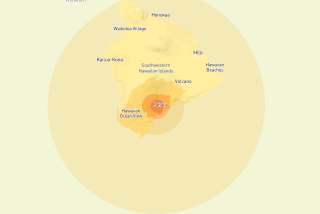Ocean volcano may be largest on Earth, biggest in solar system
A seamount in the northwestern Pacific Ocean may be the largest volcano on Earth, and could rival the largest in the solar system -- the mighty Olympus Mons on Mars -- according to oceanographers.
Tamu Massif, a well-known seamount off Japan, turns out to be one continuous shield volcano, about the size of New Mexico or the British Isles, said geophysicist William W. Sager, lead author of a study published online Thursday in the journal Nature Geoscience.
Sager and team members had long ago given names to the formations jutting up from the Shatsky Rise, a California-sized oceanic plateau southeast of Japan. Tamu, the largest of three major features, stands for Texas A&M University, where Sager conducted his research for two decades before moving recently to the University of Houston.
Tens of thousands of seamounts pock the ocean floors planet-wide, and others may be larger, such as the Ontong Java Plateau near the Solomon Islands and the Kerguelen Plateau in the southern Indian Ocean. But thus far, none appears to be a single basalt shield volcano, but rather a composite of many such volcanoes, Sager said.
“One of the real things you have as a marine geologist or marine geophysicist is that these things have found a good place to hide,” Sager said. “It’s easier to study something on the surface of Mars in many ways than it is to study something that’s right out there in the ocean. It’s not like we didn’t know that there was something out there. It’s just taken generations to get the time and money and to focus on it and get out there and study it.”
Sager’s team drilled core samples from the volcano, jutting from the ocean floor about 4 miles deep. Tamu rises about as high as many peaks of the Sierra Nevada – more than 13,000 feet. But much of its mass has sunk into the ocean crust, making it far shorter than Olympus Mons, which towers about 13 miles from the more rigid Martian surface.
But Tamu appears to have a larger base. Olympus Mons is about 374 miles in diameter, according to NASA; Tamu spans about 403 miles at its widest point and covers about about 8,000 more square miles, according to the study.
Sager was testing two competing theories of how these undersea volcanoes form. One holds that they are like continental volcanoes – the product of a rising plume of magma. Another, however, holds that the upper mantle melts without such a “hot spot” when there is a fracture or spread of the ocean lithosphere.
The question remains unresolved while geochronologists study the rock samples. “I’m still sitting on the fence,” said Sager. “Shatsky Rise sits right along a trace of a triple junction where mid-ocean ridges came together, but it also looks like what you’d expect it to look like if it was this big blob of hot material coming up.”
However the lava flowed, it flowed quickly and spread rapidly, according to the study. “We think that these things formed rapidly, within a million years or two – that’s rapidly to a geologist – and then they’re done, but we don’t know that for sure,” said Sager.
And all of the lava flow, some of it 75 feet thick, appears to trace back to one central point of origin that has a depression at its apex. “We can see that on any crossing that we make, they all seem to come from the center and go outward,” Sager said of the basalt flows. “That’s the basis of the finding that it’s one big volcano.”
Still, if you could stand on Tamu, you would not be able to discern its full profile, and might not even know which way is up. Its slopes are less than a degree – most volcanoes have slopes greater than 5 degrees.
It’s unlikely that Tamu ever was an island, even shortly after it formed about 145 million years ago. Fossils of shallow-water creatures in Tamu’s sediments indicate it came close to broaching the ocean surface before the ocean lithosphere sank to its present depth, Sager said.
Other pulses of magma may have formed nearby smaller shield volcanoes on the rise, said Sager. Those were likewise named for the universities involved in their early exploration: Ori stands for the Ocean Research Institute at the University of Tokyo, and Shirshov is for Russia’s P.P. Shirshov Institute of Oceanology.
But very little of those researchers’ early work has attracted the attention now focused on “discovering” a volcano that may be the largest in the solar system, said Sager, who has written more than 100 scientific papers in his career at Texas A&M.
“It’s rare that you get something that will make people kind of go, huh, and look at your work,” he said.







